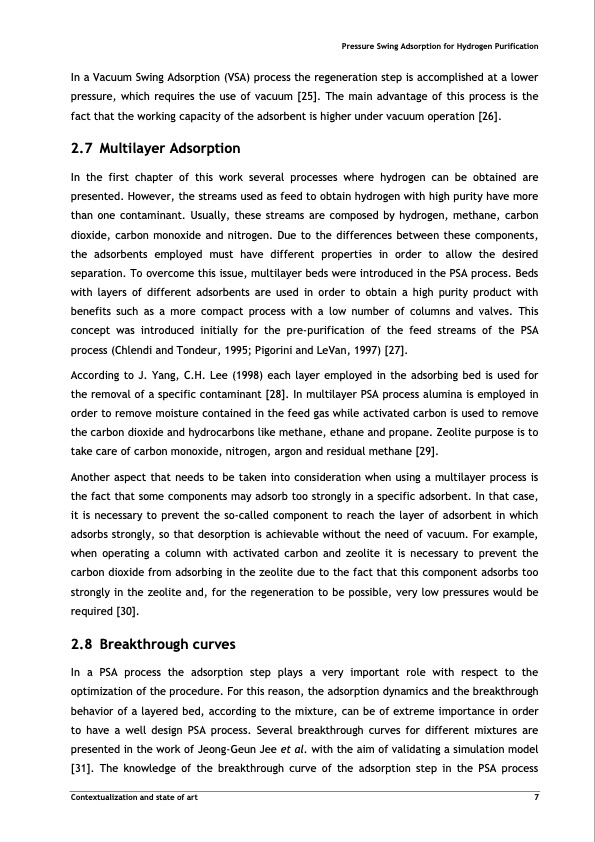
PDF Publication Title:
Text from PDF Page: 027
In a Vacuum Swing Adsorption (VSA) process the regeneration step is accomplished at a lower pressure, which requires the use of vacuum [25]. The main advantage of this process is the fact that the working capacity of the adsorbent is higher under vacuum operation [26]. 2.7 Multilayer Adsorption In the first chapter of this work several processes where hydrogen can be obtained are presented. However, the streams used as feed to obtain hydrogen with high purity have more than one contaminant. Usually, these streams are composed by hydrogen, methane, carbon dioxide, carbon monoxide and nitrogen. Due to the differences between these components, the adsorbents employed must have different properties in order to allow the desired separation. To overcome this issue, multilayer beds were introduced in the PSA process. Beds with layers of different adsorbents are used in order to obtain a high purity product with benefits such as a more compact process with a low number of columns and valves. This concept was introduced initially for the pre-purification of the feed streams of the PSA process (Chlendi and Tondeur, 1995; Pigorini and LeVan, 1997) [27]. According to J. Yang, C.H. Lee (1998) each layer employed in the adsorbing bed is used for the removal of a specific contaminant [28]. In multilayer PSA process alumina is employed in order to remove moisture contained in the feed gas while activated carbon is used to remove the carbon dioxide and hydrocarbons like methane, ethane and propane. Zeolite purpose is to take care of carbon monoxide, nitrogen, argon and residual methane [29]. Another aspect that needs to be taken into consideration when using a multilayer process is the fact that some components may adsorb too strongly in a specific adsorbent. In that case, it is necessary to prevent the so-called component to reach the layer of adsorbent in which adsorbs strongly, so that desorption is achievable without the need of vacuum. For example, when operating a column with activated carbon and zeolite it is necessary to prevent the carbon dioxide from adsorbing in the zeolite due to the fact that this component adsorbs too strongly in the zeolite and, for the regeneration to be possible, very low pressures would be required [30]. 2.8 Breakthrough curves In a PSA process the adsorption step plays a very important role with respect to the optimization of the procedure. For this reason, the adsorption dynamics and the breakthrough behavior of a layered bed, according to the mixture, can be of extreme importance in order to have a well design PSA process. Several breakthrough curves for different mixtures are presented in the work of Jeong-Geun Jee et al. with the aim of validating a simulation model [31]. The knowledge of the breakthrough curve of the adsorption step in the PSA process Pressure Swing Adsorption for Hydrogen Purification Contextualization and state of art 7PDF Image | PRESSURE SWING ADSORPTION FOR THE PURIFICATION OF HYDROGEN

PDF Search Title:
PRESSURE SWING ADSORPTION FOR THE PURIFICATION OF HYDROGENOriginal File Name Searched:
32541.pdfDIY PDF Search: Google It | Yahoo | Bing
CO2 Organic Rankine Cycle Experimenter Platform The supercritical CO2 phase change system is both a heat pump and organic rankine cycle which can be used for those purposes and as a supercritical extractor for advanced subcritical and supercritical extraction technology. Uses include producing nanoparticles, precious metal CO2 extraction, lithium battery recycling, and other applications... More Info
Heat Pumps CO2 ORC Heat Pump System Platform More Info
| CONTACT TEL: 608-238-6001 Email: greg@infinityturbine.com | RSS | AMP |